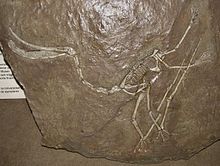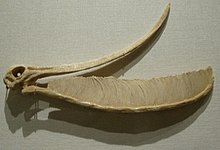
Pterodaustro is a genus of ctenochasmatid pterodactyloid pterosaur from South America. Its fossil remains dated back to the Early Cretaceous period, about 105 million years ago.

Cearadactylus is a genus of large anhanguerid pterodactyloid pterosaur from the Romualdo Formation of Brazil, South America. Fossil remains of Cearadactylus dated back to the Albian stage of the Early Cretaceous period, about 112 million years ago. The only known species is C. atrox, described and named in 1985 by Giuseppe Leonardi and Guido Borgomanero. The name refers to the Brazilian state Ceará, and combines this with Greek daktylos, "finger", a reference to the wing finger of pterosaurs. The Latin atrox means "frightful", a reference to the fearsome dentition of the species.
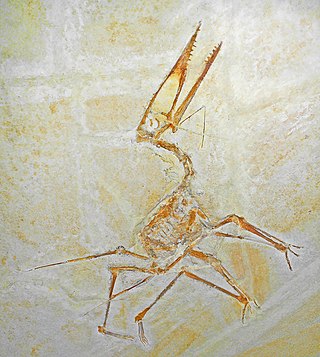
Germanodactylus is a genus of germanodactylid pterodactyloid pterosaur from Upper Jurassic-age rocks of Germany, including the Solnhofen Limestone. Its specimens were long thought to pertain to Pterodactylus. The head crest of Germanodactylus is a distinctive feature.

Gnathosaurus is a genus of ctenochasmatid pterosaur containing two species: G. subulatus, named in 1833 from the Solnhofen Limestone of Germany, and G. macrurus, known from the Purbeck Limestone of the UK. Its fossil remains dated back to the Late Jurassic period.
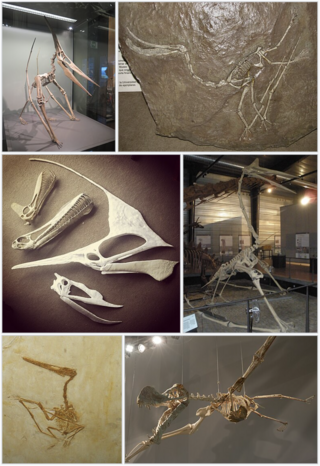
Pterodactyloidea is one of the two traditional suborders of pterosaurs, and contains the most derived members of this group of flying reptiles. They appeared during the middle Jurassic Period, and differ from the basal rhamphorhynchoids by their short tails and long wing metacarpals. The most advanced forms also lack teeth, and by the late Cretaceous, all known pterodactyloids were toothless. Many species had well-developed crests on the skull, a form of display taken to extremes in giant-crested forms like Nyctosaurus and Tupandactylus. Pterodactyloids were the last surviving pterosaurs when the order became extinct at the end of the Cretaceous Period, together with the non-avian dinosaurs and most marine reptiles.

Gallodactylidae is a group of pterosaurs within the suborder Pterodactyloidea. Gallodactylids differed from other related pterosaurs in several distinct features, including fewer than 50 teeth present only in the jaw tips, and rounded crests present on the rear portion of the skull and jaws but not near the ends of their snouts. At least some species possessed jaw flanges, possibly used to bissect hard-shelled prey.

Pterodactylidae is a controversial group of pterosaurs. During the 2000s and 2010s, several competing definitions for the various Jurassic pterodactyloid groups were proposed. Pereda-Suberbiola et al. (2012) used Fabien Knoll's (2000) definition of the name Pterodactylidae. Knoll had defined Pterodactylidae as a clade containing "Pterodactylus antiquus, Ctenochasma elegans, their most recent common ancestor and all its descendants". Using this definition with the analysis conducted by Pereda-Suberbiola et al. (2012) meant that Ctenochasmatoidea was nested inside Pterodactylidae.
Boreopterus is a genus of boreopterid pterodactyloid pterosaur from the Barremian-Aptian-age Lower Cretaceous Yixian Formation of Dalian, Liaoning, China.
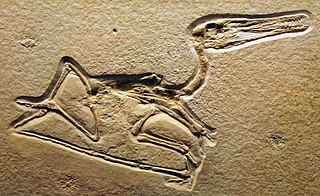
Diopecephalus is a genus of pterodactyloid pterosaur from the Lower Tithonian of the Lithographic Limestone, Bavaria, Germany. The type and only species is D. kochi, although the name has been applied to Pterodactylus longicollum, with longicollum erroneously listed as the type species.

Feilongus is an extinct genus of ctenochasmatid pterodactyloid pterosaur from the Barremian–Aptian-age Lower Cretaceous Yixian Formation of Beipiao, Liaoning, China.

Ludodactylus is a genus of anhanguerid pterodactyloid pterosaur from the Early Cretaceous period of what is now the Crato Formation of the Araripe Basin in Ceará, Brazil. The type and only species is L. sibbicki. The generic name Ludodactylus refers to the fact that the animal had the combination of teeth and a Pteranodon-like head crest, similar to many toy pterosaurs, and no such creature was known to exist until the discovery of Ludodactylus. However, Ludodactylus is not the only pterosaur known to possess these features, its very close relative Caulkicephalus is another example.

Lonchodectes was a genus of lonchodectid pterosaur from several formations dating to the Turonian of England, mostly in the area around Kent. The species belonging to it had been assigned to Ornithocheirus until David Unwin's work of the 1990s and 2000s. Several potential species are known; most are based on scrappy remains, and have gone through several other generic assignments. The genus is part of the complex taxonomy issues surrounding Early Cretaceous pterosaurs from Brazil and England, such as Amblydectes, Anhanguera, Coloborhynchus, and Ornithocheirus.

Lonchodectidae or Lonchodraconidae is a group of pterosaurs within the clade Pterodactyloidea. It has variously been considered to be within Ctenochasmatoidea, Azhdarchoidea and Pteranodontoidea. They are notable for their high, conical tooth sockets and raised alveolar margins.

Ctenochasmatoidea is a group of early pterosaurs within the suborder Pterodactyloidea. Their remains are usually found in what were once coastal or lake environments. They generally had long wings, long necks, and highly specialized teeth.

Zhenyuanopterus is a genus of boreopterid pterosaur which is known from Lower Cretaceous Yixian Formation of Liaoning, China. It contains one species, Zhenyuanopterus longirostris, which was first described and named by Lü Junchang.

Boreopteridae is a group of pterodactyloid pterosaurs from the Aptian-age Lower Cretaceous Yixian Formation of Liaoning, China.

Moganopterus is an extinct genus of ctenochasmatid pterosaur from the Early Cretaceous of western Liaoning Province, China.
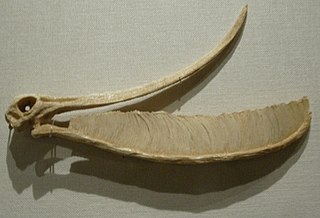
Archaeopterodactyloidea is an extinct clade of pterodactyloid pterosaurs that lived from the middle Late Jurassic to the latest Early Cretaceous periods of Africa, Asia, Europe and North America. It was named by Alexander Wilhelm Armin Kellner in 1996 as the group that contains Germanodactylus, Pterodactylus, the Ctenochasmatidae and the Gallodactylidae. In 2003, Kellner defined the clade as a node-based taxon consisting of the last common ancestor of Pterodactylus, Ctenochasma and Gallodactylus and all its descendants. Although phylogenetic analyses that based on David Unwin's 2003 analysis do not recover monophyletic Archaeopterodactyloidea, phylogenetic analyses that based on Kellner's analyses, or the analyses of Brian Andres recover monophyletic Archaeopterodactyloidea at the base of the Pterodactyloidea.

Ornithocheiromorpha is a group of pterosaurs within the suborder Pterodactyloidea. Fossil remains of this group date back from the Early to Late Cretaceous periods, around 140 to 92.5 million years ago. Ornithocheiromorphs have been discovered worldwide except Antarctica, though most genera have been recovered in Europe, Asia and South America. They were the most diverse and successful pterosaurs during the Early Cretaceous, but throughout the Late Cretaceous they were replaced by pteranodontians and azhdarchoids. The Ornithocheiromorpha was defined in 2014 by Andres and colleagues, and they made Ornithocheiromorpha the most inclusive clade containing Ornithocheirus, but not Pteranodon.
Pangupterus is a genus of pterodactyloid pterosaur from the Early Cretaceous Jiufotang Formation of China. It was first described and named by Lü Junchang et al.

